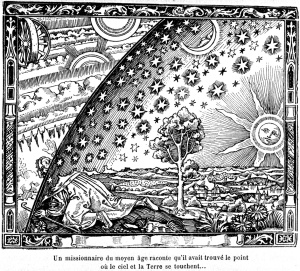-
We seem to be looking for answers in all the wrong places and thus perennially caught in the ‘god between the gaps’ argument. Theists demand that science cannot answer the question definitively, then pull their collective hairs out applying bad science to prove otherwise.
We argue complicated theories of evolution, cosmology, physics, gravity, thermodynamics, singularity and in doing so parse interminably about their implications, for, or against, when, perhaps, these scientific disciplines are not, should not, and cannot bother themselves with such an impossible inquiry in the first place. In lieu of scientific evidence, the argument switches over to philosophy, religion, morality and theology. Unfortunately, these disciplines can only satisfy one side of the argument as they are not legitimate fields of inquiry for their detractors. For the atheist, dredging religion, morality and theology for answers is tantamount to using the Lord of the Rings to prove the existence of elves.
We argue under vague terms of science and reason and constantly arrive at an impasse, when there is a whole other branch of scientific inquiry with volumes and volumes of hard evidence, confirming historical and cultural artifacts, hundreds of years of research by hundreds of concurring and contributing scholars and scientists who answer all these mysteries with an impressive body of information.
The problem is most people, theist and atheist alike, are astonishingly unaware of how comprehensive it is. No doubt religionists will reject it because they are hard wired against describing the dogma and canon of their faith as myth. And, most atheists mistakenly assign mythology to a quaint system of collecting fairy tales and ethnic eccentricities. The reality is that Mythology is the study of both the science and art of storytelling and human evolution exactly where the search for that elusive Wild One can be vigorously investigated, gloriously revealed, and ultimately resolved.
“Let us ask, therefore: What can the value or meaning be of a mythological notion which, in the light of modern science, must be said to be erroneous, philosophically false, absurd, or even formally insane? The first answer suggested will no doubt be the one that, in the course of the past century, has been offered many times by our leading thinkers. The value, namely, is to be studied rather as a function of psychology and sociology than as a refuted system of positivistic science, rather in terms of certain effects worked by the symbols on the character of the individual and the structure of society than in terms of their obvious incongruity as an image of the cosmos. Their value, in other words, is not that of science but of art: and just as art may be studied psychologically, as symbolic or symptomatic of the strains and structures of the psyche, so may the archetypes of myth, fairy tale, archaic philosophy, cosmology, and metaphysics.”
Joseph Campbell, “The Symbol without Meaning,” Flight of the Wild Gander, p.98-99
-
Subscribe
Subscribed
Already have a WordPress.com account? Log in now.
